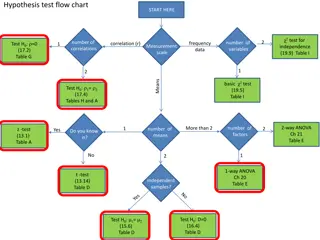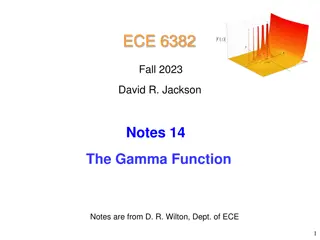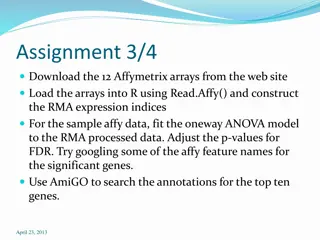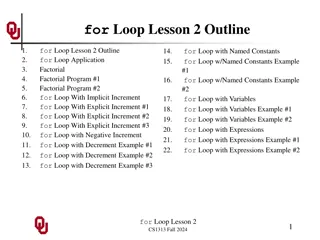Factorial ANOVA Experiment Analysis
Dr. Petrov is exploring the impact of teaching methods and sex differences on learning outcomes through a factorial ANOVA experiment. The study involves different factors such as teaching method, sex, and student participation, aiming to assess how these variables interact and influence the results. With a focus on ANOVA design variations and means table analysis, the experiment delves into the complexity of educational research methodologies.
Download Presentation

Please find below an Image/Link to download the presentation.
The content on the website is provided AS IS for your information and personal use only. It may not be sold, licensed, or shared on other websites without obtaining consent from the author.If you encounter any issues during the download, it is possible that the publisher has removed the file from their server.
You are allowed to download the files provided on this website for personal or commercial use, subject to the condition that they are used lawfully. All files are the property of their respective owners.
The content on the website is provided AS IS for your information and personal use only. It may not be sold, licensed, or shared on other websites without obtaining consent from the author.
E N D
Presentation Transcript
Adapted from notes by Prof. Jeffery T. Williams ECE 5317-6351 Microwave Engineering Fall 2019 Prof. David R. Jackson Dept. of ECE Notes 4 Transmission Lines Part 3: Baluns 1
Baluns Baluns are used to connect coaxial cables to twin leads. They suppress the common mode currents on the transmission lines. Balun: Balanced to unbalanced Coaxial cable: an unbalanced transmission line Twin lead: a balanced transmission line 4:1 impedance-transforming baluns, connecting 75 TV coax to 300 TV twin lead https://en.wikipedia.org/wiki/Balun 2
Baluns (cont.) Baluns are also used to connect coax (unbalanced line) to dipole antennas (balanced). http://www.ukradioamateur.co.uk/foundation/gfx/dwg/balun.gif Baluns are present in radars, transmitters, satellites, in every telephone network, and probably in most wireless network modem/routers used in homes. https://en.wikipedia.org/wiki/Balun 3
Baluns (cont.) What does balanced and unbalanced mean? + - + 0 Ground (zero volts) Ground (zero volts) Coax Twin Lead The voltages are usually unbalanced with respect to ground. The voltages are usually balanced with respect to ground. Note: If the coax outer conductor was not at zero volts, there would be a field between the coax and the ground. There would be charge and current on the outside of the coax. This would correspond to a common mode . 4
Baluns (cont.) Baluns are necessary because, in practice, the two transmission lines are always both running over a ground plane. If there were no ground plane, and you only had the two lines connected to each other, then a balun would not be necessary. (But you would still want to have a matching network between the two lines if they have different characteristic impedances.) Z 0 Z 0 Coax Twin Lead No ground plane 5
Baluns (cont.) When a ground plane is present, we really have three conductors, forming a multiconductortransmission line, and this system supports two different modes. - + + + Differential mode Common mode (desired) (undesired) The differential and common modes are shown for a twin lead over ground. For the common mode, both conductors of the transmission line act as one net conductor, while the ground plane acts as the other conductor (return path for the current). 6
Baluns (cont.) Differential mode: currents are equal and opposite Ground Common mode: a net current flows on the two conductors Ground 7
Baluns (cont.) + - + - Differential mode Common mode (desired) (undesired) The differential and common modes are shown for a coax over ground. (The red flux lines show the electric field.) 8
Baluns for Coax to Twin Lead Because of the asymmetry, a common mode current will get excited at the junction between the two lines, and propagate away from the junction. No Balun Common mode Common mode Differential mode Z Differential mode 0 Z Coax 0 Twin Lead Ground Note: If the height above the ground plane goes to infinity, the characteristic impedance of the common mode goes to infinity, and there is no common mode current we would not need a balun. 9
Baluns for Coax to Twin Lead (cont.) A balun prevents common modes from being excited at the junction between a coax and a twin lead. With Balun Differential mode Differential mode Z 0 Z Balun 0 Coax Twin Lead Ground 10
Baluns for Coax to Twin Lead (cont.) From another point of view, a balun prevents currents from flowing on the outside of the coax. No Balun Assume we have some amount of common mode. I I I1 Z 2 1 0 I1 Z I2 I1 0 Coax I2-I1 Twin Lead (current on outside of the coax) Ground 11
Baluns for Coax to Twin Lead (cont.) A simple model for the mode excitation at the junction The coax is replaced by a solid tube with a voltage source at the end. 0V - + Solid tube Twin Lead Ground 12
Baluns for Coax to Twin Lead (cont.) Next, we use superposition. - + 0/2 V Differential mode +- Solid tube 0/2 V Twin Lead Ground + - + 0/2 V Common mode - + Solid tube 0/2 V Twin Lead Ground 13
Baluns and Grounding Baluns are also useful whenever one transmission line is grounded and the other one isn t. The twin lead is now forced to also be grounded. No Balun Twin Lead Ground 14
Baluns and Grounding (cont.) Baluns are also useful whenever one transmission line is grounded and the other one isn t. The twin lead is now ungrounded (this is the usual case for twin lead). With Balun Balun Coax Twin Lead Ground 15
Baluns using Transformers One type of balun uses an isolation transformer. 0I 0V 0 0I 0/2 I 0/2 I 0/2 I 0V 0V 0/2 I The input and output are isolated from each other, so the input can be grounded if desired (e.g., when using a coax feed for the primary) while the output is not (e.g., when using a twin lead feed for the secondary). The common mode must be zero at the transformer, since a net current cannot flow off of the windings into the transformer core. This balun uses a 4:1 autotransformer, having three taps on a single winding, on a ferrite rod. The center tap on the input can be grounded if desired, while the balanced output is not. The common mode is choked off due to the high impedance of the coil. https://en.wikipedia.org/wiki/Balun 16
Baluns using Transformers (cont.) Here is a more exotic type of 4:1 impedance transforming balun. Guanella balun Balanced and ungrounded twin lead output Unbalanced and grounded coax input 0/2 I 0V 0V 0I 0V 0V 0 0 0/2 I 0V 0 0 0/2 I 0I 0 0 0/2 I 0V 0 This balun uses two 1:1 transformers to achieve symmetric (and ungrounded) output voltages. 17
Baluns using Transformers (cont.) Inside of 4:1 impedance transforming VHF/UHF balun for TV http://mikeyancey.com/photo/FM_Antenna/Balun.jpg Ferrite core 18
Balun using Coax A 4:1 impedance transforming balun built using only coax Z 0I 0 0/ 2 I 0 V 0 V Unbalanced 0/ 2 I Balanced 4Z 0 0/ 2 I 0 V / 2 The two outputs are 180o out of phase. (See slide 24 for a microstrip version.) 19
Choke Baluns Another type of balun uses a choke to choke off the common mode. A coax is wound around a ferrite core. This creates a large inductance for the common mode, while it does not affect the differential mode (whose fields are confined inside the coax). https://en.wikipedia.org/wiki/Balun 20
Microstrip Line Coax can be used to feed a microstrip line on a PCB without needing a balun. Both the microstrip line (with ground plane) and the coax are two-conductor transmission line systems, so there is no common mode. 21
Baluns and CPS Line Baluns are very useful for feeding differential circuits with coax on PCBs. CPS line No balun Without a balun, there would be a common mode current on the coplanar strips (CPS) line. 22
Baluns and CPS Line (cont.) Superposition allows us to see what the problem is. = +- +- +- 0/2 V 0/2 V 0V + Excites undesired common mode Excites desired differential mode -+ +- 0/2 V 0/2 V 23
Baluns and CPS Line (cont.) Baluns for CPS can be implemented in microstrip form. http://www.hindawi.com/journals/ijap/2013/651040.fig.001a.jpg https://encrypted-tbn1.gstatic.com/images?q=tbn:ANd9GcTQJdEMGoy8NKU54PJRqBBo-3WZgjONff_G5rn6X8eB1d0a8NP6EA Coax feed port Paired-strip output Tapered balun Coax feed port Balun feeding a microstrip Yagi-Uda antenna 24
Baluns and CPS Line (cont.) Baluns for CPS can be implemented in other microstrip forms. http://m.eet.com/media/1048752/AWR_MIXER_FIG2.gif Marchand balun https://upload.wikimedia.org/wikipedia/commons/thumb/b/b7/Ratracecoupler-arithmetics.svg/2000px-Ratracecoupler-arithmetics.svg.png Null output Input #2 (balanced) Output (unbalanced) Input #1 (balanced) 180o hybrid rat-race coupler used as a balun 25
Baluns for Antennas If you try to feed a dipole antenna directly with coax, there will be a common mode current on the coax. = I I 1 2 I 0 3 I I 4 1 No balun 26
Baluns for Antennas (cont.) The equivalent circuit explains why there is a common mode on the coax. aI bI +- cI = + I I I a b c Note: I I The voltage source sees an asymmetric structure. The current flowing to the right has two possible paths. a b No balun 27
Baluns for Antennas (cont.) Baluns are commonly used to feed dipole antennas from coax. http://cdn.instructables.com/FLW/PQDW/FMSGGNWS/FLWPQDWFMSGGNWS.MEDIUM.jpg A balun first converts the coax to a twin lead, and then the twin lead feeds the dipole. 28
Baluns for Antennas (cont.) Baluns are commonly used to feed dipole antennas from coax. Twin Arm Balun This acts like voltage source for the dipole, which forces the differential mode. http://www.antennamagus.com/blog/resources/2009/10/sideview_with_semi-rigid.png /4 The dipole is loaded by a short-circuited section of twin lead (composed of the two hollow pipes). This is an open circuit at the source location because of the /4 height. 29
Baluns for Antennas (cont.) Equivalent Circuit http://www.antennamagus.com/blog/resources/2009/10/sideview_with_semi-rigid.png +- 0/ 4 0/ 4 Short The equivalent circuit shows us that the current on the dipole arms are perfectly balanced. The voltage source sees the dipole in parallel with a short-circuited length of twin lead (made from the vertical pipes) of length 0 / 4. 30
Baluns for Antennas (cont.) Another balun for feeding a dipole antenna from coax. Split Coax Balun 0/ 4 The operation here is very similar to the previous balun. Both sides of the coax are split. 31
Baluns for Antennas (cont.) Another balun for feeding a dipole antenna from coax. http://www.tuks.nl/img/sleeve_files/sleeve.gif Bazooka Balun ( ) = in end 0 / 4 I 0 out end I ( ) = in end out end I I KCL in end I 0/ 4 = out end 0 I The current on the inside and outside of the sleeve is forced to be zero at the top of the sleeve (open circuit). This makes it small everywhere on the outside. Coaxial sleeve region A sleeve balun directly connects a coax to a dipole. 32
Baluns for Antennas (cont.) A balun is not always necessary when feeding an antenna. Twin lead Dipole antenna The system stays balanced no common mode. Monopole antenna Infinite ground plane Coax Current cannot flow on the outside of the coax. 33
Baluns and Measuring Probes Baluns can be important when connecting to unbalanced devices like oscilloscopes. Wires OSC Coax input Measuring probe No Balun There may be a strong common mode current on the two coax wires. The coax wires will act as an antenna! You may not really be measuring the field from the probe. 34
Baluns and Measuring Probes (cont.) Baluns can be important when connecting to unbalanced devices like oscilloscopes. Coax OSC Coax input Measuring probe No Balun Now there is a common mode on the coax. The coax will act as an antenna! You may not really be measuring the field from the probe. 35
Baluns and Measuring Probes (cont.) Baluns can be important when connecting to unbalanced devices like oscilloscopes. Balun Coax OSC Coax input Measuring probe With Balun Now there is only a differential mode on the coax, and the coax acts as a transmission line. We measure what is coming from the probe. 36























